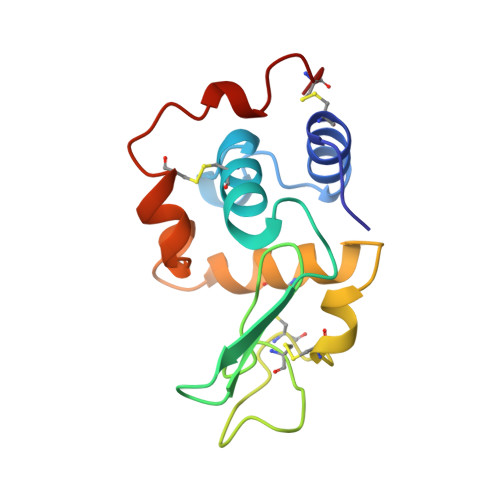Contribution of intra- and intermolecular hydrogen bonds to the conformational stability of human lysozyme(,).
Takano, K., Yamagata, Y., Funahashi, J., Hioki, Y., Kuramitsu, S., Yutani, K.(1999) Biochemistry 38: 12698-12708
- PubMed: 10504240
- DOI: https://doi.org/10.1021/bi9910169
- Primary Citation of Related Structures:
1CJ6, 1CJ7, 1CJ8, 1CJ9, 1CKC, 1CKD, 1CKF, 1CKG, 1CKH - PubMed Abstract:
In globular proteins, there are intermolecular hydrogen bonds between protein and water molecules, and between water molecules, which are bound with the proteins, in addition to intramolecular hydrogen bonds. To estimate the contribution of these hydrogen bonds to the conformational stability of a protein, the thermodynamic parameters for denaturation and the crystal structures of five Thr to Val and five Thr to Ala mutant human lysozymes were determined. The denaturation Gibbs energy (DeltaG) of Thr to Val and Thr to Ala mutant proteins was changed from 4.0 to -5.6 kJ/mol and from 1.6 to -6.3 kJ/mol, respectively, compared with that of the wild-type protein. The contribution of hydrogen bonds to the stability (DeltaDeltaG(HB)) of the Thr and other mutant human lysozymes previously reported was extracted from the observed stability changes (DeltaDeltaG) with correction for changes in hydrophobicity and side chain conformational entropy between the wild-type and mutant structures. The estimation of the DeltaDeltaG(HB) values of all mutant proteins after removal of hydrogen bonds, including protein-water hydrogen bonds, indicates a favorable contribution of the intra- and intermolecular hydrogen bonds to the protein stability. The net contribution of an intramolecular hydrogen bond (DeltaG(HB[pp])), an intermolecular one between protein and ordered water molecules (DeltaG(HB[pw])), and an intermolecular one between ordered water molecules (DeltaG(HB[ww])) could be estimated to be 8. 5, 5.2, and 5.0 kJ/mol, respectively, for a 3 A long hydrogen bond. This result shows the different contributions to protein stability of intra- and intermolecular hydrogen bonds. The entropic cost due to the introduction of a water molecule (DeltaG(H)()2(O)) could be also estimated to be about 8 kJ/mol.
- Institute for Protein Research, Osaka University, Yamadaoka, Suita, Osaka 565-0871, Japan, Graduate School of Pharmaceutical Sciences, Osaka University, Yamadaoka, Suita, Osaka 565-0871, Japan.
Organizational Affiliation:

















